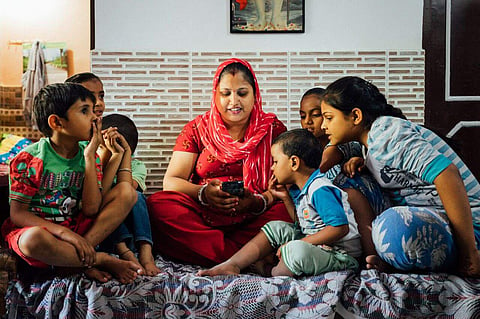

Worldreader, a global non-profit organization that provides people in the developing world with free access to a library of digital books via e-readers and mobile phones, in partnership with Pearson, as part of the Project Literacy campaign launched a pilot project 'Read to Kids' in Delhi from 2015 to 2017 and reached over 200,000 families with digital books via the Worldreader Kids app (www.readtokids.com).
The first digitally focused literacy intervention of this kind, 'Read to Kids' leveraged a behaviour change campaign and partnered with community-based organizations to raise awareness on the importance of reading to children from birth.And the results were surprising. The two-year digital reading pilot campaign reveals how parents’ and caregivers’ reading habits changed after receiving access to a free mobile library of children’s books alongside community-based education about the benefits of reading to children from a young age.
The report contributes to growing evidence on how the world is moving towards digitisation and how parents can support their children’s early learning using technology. According to the report, nearly 7,000 households demonstrated a deeper change in their reading habits, becoming “frequent readers” who read from the application at least four times a month.
So, does this mean people are more comfortable reading from digital and interactive platforms than just from normal books? From the results of this campaign, it became evident that providing access to digital books in and of itself can trigger parental interest in reading to their kids. While a wide range of reading frequencies was observed, there was particular attention paid to evidence of behaviour change and habit development. The Read to Kids pilot reached 203,000 households with digital books, among which 57,000 individuals browsed the library and read at least one book. Approximately 7,000 of these users became frequent readers to children.
"Widespread mobile phone connectivity, the declining cost of hardware devices and increasingly affordable digital content have made digital book delivery a viable low-cost solution for many developing countries. Digital literacy is increasing in many communities, even the most vulnerable. Increasingly mobile technology is a source of content of all types (videos, books, information) and participation in this digital space is affordable," says Annya Crane, Program Manager - WorldReader.
She adds "Mass-market mobile phones using 2G, 3G and 4G networks, provide almost immediate access to hundreds of thousands of books and are easy to connect to existing mobile and Wi-Fi networks. Mobile phones allow users to reach hundreds of thousands of people via devices they already carry in their pockets. Finally, the cost for the end user will keep getting more and more affordable, in recent years the cost of data has drastically dropped; 1gb per day that cost Rs 50 one year ago will today cost Rs 10."
Another notable outcome that was observed was books in Hindi (bilingual or Hindi only) were the most-read books on the application. People preferred books in mother tongue but English was also frequently read and reflected parental aspirations for early exposure to English.
"Many parents of young children prefer to read or tell stories to their children in the language spoken in the home. A great deal of research supports that hearing stories and being read to first in mother tongue helps with improved reading skills once a child enters primary school. The families in our target audience were mostly Hindi-speaking families, with Hindi as their mother tongue. Findings from the pilot showed that 60 per cent of reading happened in Hindi or with bilingual books (English/Hindi) and 40 per cent was in English," says Annya.
The campaign used a web app11 designed to have universal compatibility with all data-enabled mobile devices, including both feature phones and smartphones. The choice of the web app ensured access to the library in households with even the simplest data-enabled phone of any brand. The web app was placed in the Google Play store to promote discoverability.
"Whether accessed via a mobile browser or the Android operating system, the content in the Worldreader Kids library is the same. Internet connectivity is required to access the app, but users can download books for offline reading. Being able to read offline was particularly important in those communities where connectivity was poor, such as in the narrow alleys of busy communities or for those users, often mothers, who didn’t have a large data pack linked to their phone," explains Annya.
The results also show that digital reading is scalable and affordable. App promotion and downloads cost Worldreader approximately $0.30 USD per user. This low cost of app promotion coupled with widespread availability of mobile phones in India supported affordable access to their digital books. India’s aggressive cell phone market translates to low data costs for the end user so that online digital reading is an affordable option, even for low-income parents. Reading a book a day for thirty days cost the equivalent of two cups of street chai, or about $0.16 USD per month.
"The main advantage is that publishing and distributing e-books is more cost-effective than paper books. It is also less expensive for the end user, thanks to apps such as Worldreader Kids. For example, a family that before had access to one or two children’s books can now have access to over 500 books at their fingertips for free," she concludes.
